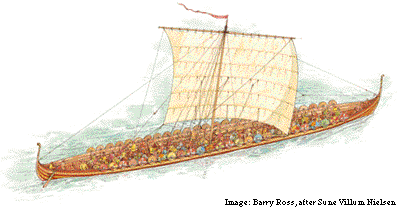Norse tech and the settlement of the Americas
Printed From: History Community ~ All Empires
Category: Regional History or Period History
Forum Name: History of the Americas
Forum Discription: The Americas: History from pre-Colombian times to the present
URL: http://www.allempires.com/forum/forum_posts.asp?TID=25904
Printed Date: 14-May-2024 at 19:20
Software Version: Web Wiz Forums 9.56a - http://www.webwizforums.com
Topic: Norse tech and the settlement of the Americas
Posted By: Guests
Subject: Norse tech and the settlement of the Americas
Date Posted: 14-Nov-2008 at 02:29
|
Something that makes me feel very upset is the so many pseudohistorical thesis about people from the Old World comming to the Americas across the sea. Make me feel upset because that wasn't an easy task at all. Theirs argument is something like this "If the vikings reached the Americas, then everybody else's did...
These fellows forget the following. Besides Polynesians that was an extraordinary people, the most outstanding sailors of theirs times were -without doubt- the Norse!!! It is not a casuality they reached the Americas by sea because, of all the people of the Western part of Eurasia, they were the best sailors and the most prepared people to do so.
I remember a exhibition about the Norse some years ago in Chile, and how surprised I was when I saw theirs tools !! Amazingly modern.
Let's discuss, please, the technology available to the norse to cross the Atlantic. Later I will put some picture about it.
|
Replies:
Posted By: Reginmund
Date Posted: 14-Nov-2008 at 09:01
|
I suppose their innovative ship design, with a light, streamlined hulk for maximum speed, was the most important technology in crossing the Atlantic. I don't know what other tools you are referring to, naval gear or everyday utensils? I don't know if you are aware, but there is a particularly farfetched theory claiming the Norse, on discovering America, followed the coast further south and came into contact with the native civilizations of southern America. Allegedly these Norsemen did quite well for themselves and rose to high status among the natives, giving rise to the legend about Quetzalcoatl, the serpent rafts and the bearded men who would some day return. Of course when the bearded men returned they were Spaniards and Portuguese who were less inclined to adjust to native society, to put it mildly. In any case it's just speculation. http://archaeology.suite101.com/article.cfm/the_vikingmaya_connection - http://archaeology.suite101.com/article.cfm/the_vikingmaya_connection ------------- |
Posted By: Jams
Date Posted: 14-Nov-2008 at 11:41
|
I've heard of that idea, but I believe the original myth of Quetzalcoatl is probbly older than the Norse settlements. Anyway, the Sagas does not support the idea. The Sagas however, seems to be fairly trustworthy in some way, because the remains found correlate quite well with the description in the Sagas. ------------- |
Posted By: Guests
Date Posted: 14-Nov-2008 at 16:46
I was talking about theirs techniques of shipbuilding. They reinforced theirs ships with iron ribbets. Besides, they had navigation tools like the sun compass; something other peoples didn't know.
If I am not wrong, Quetzalcoatl is previous to the Norse settlements in Greenland. Besides, it is based in a real human being whose history is sort of understood, more or less. Norse never were so far down South at all. ------------- |
Posted By: ehecatzin
Date Posted: 14-Nov-2008 at 21:33
I agree, the Nords were very competent sailors, who travelled the
northern sea in a daily basis, that alone should give us an idea of how
skilled they were.
The part that bothers me so much of that theory, is not that its far fetched (its actually ridiculous) but that despite being pure fantasy many people consider it to be true, and it keeps popping in most discussions about european pre columbus sea exploration. Quetzalcoatl, or the feathered snake to be more precise, has been present in mesoamerica since the olmec civilization, along with other just as old concepts that became a core of their religous belief sistem, like the calendar, jaguar/feathered snake dualism, sacrifice, piramids, urban planning, etc. so did these lost vikings tought them all that? and while we are at it, why didnt they teach them how to sail or some metalurgy like bronze, how about something even more basic like a cart wheel? Im sure these vikings knew how to make one. Anyway, I dont want to sound agressive or anything like that, the whole subject just gets on my nerves. The thing that we must be aware of when we talk about Quetzalcoatl, is that Quetzalcoatl was many diferent things across mesoamerican history, he is the feathered snake, which in Olmec times and Teotihuacan time simbolized rivers rather than wind, he was the ruler of the mythical city of Tollan (which is still being argued if is Teotihuacan or Tula) and was also the title of the Toltec rulers (who apparently had a very powerful theocratic class, wich explains the title). Finally when its mentioned in central Mexico civilizations that Quetzalcoatl went east...well east of Mexico highlands is: Yucatan! and, as we know, Teotihuacan and Toltec influence was present in Maya history, I guess its more realistic to think that by east they meant Yucatan rather than Europe. |
Posted By: Guests
Date Posted: 15-Nov-2008 at 01:46
Well, there is no need to get upset. That's the effect "King Kong" in popular culture. The idea that natives will receive gladly to foreigners and consider them gods. The facts couldn't be more different. Remember that Cook was killed by natives in Polynesia, and several others god-pretenders were killed on site as well. Even more, people like the Apaches, Sioux, Mayans, Amazonians and Araucanians never gave up and kept fighting up to very recent times.
With respect to Norse reaching Mexico, if they have had, Mexicans wouldn't be so naive when the real danger of the Spaniards finally arrived, that's for sure. Norse had similar problems with the pre-Inuit populations of Greenland and with Inuits themselves and as far as I know Norse weren't considered gods among them.
------------- |
Posted By: Guests
Date Posted: 15-Nov-2008 at 01:59
|
Well, the thread is about Norse technology. Here is some example of the sun compass. It was a tool similar to a gnomon that help to find the trajectory of a ship at sea. 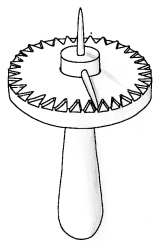  A description, from:
http://home.comcast.net/~saville/backstaffhome.html - http://home.comcast.net/~saville/backstaffhome.html
The Viking Sun Compass is an ingenious device which allows the navigator to know where North was and, therefore, what direction he was sailing.
The Sun compass is essentially a sundial used in "reverse". Imagine a circular wooden disk about 4 or 4 inches in diameter set level to the ground. From the center rises a thin post or gnomon. When the sun is out, the gnomon casts a shadow on the disk. Were you to mark the position of the tip of the shadow each half an hour, and then connect the points, you would generate an arc. That arc is a recording of the sun's height during the day, at that time of year, at that latitude. If you drew a line from the center of the gnomon, to the point on the arc that was closest to the gnomon, you will have defined True North on the sun compass. From there you can mark out the rest of the 32 points of a compass. Now you've calibrated the Sun Compass. To use the compass you shove off to sea and wait for a sunny day. You must know whether it's morning or the afternoon. Once you know that, if you hold the Sun Compass completely level, and then spin the disk about it's axis (about the gonomon) there is one and only one point where the tip of the shadow cast by the gnomon touches the curve you drew. The compass is now oriented. You now look at the compass marks to determine which direction is North (or South etc.).
------------- |
Posted By: Count Belisarius
Date Posted: 15-Nov-2008 at 02:25
|
I saw an article on BBC where a prof found viking telescopic viewing lenses that were almost perfect ellipsoids ------------- 
Defenders of Ulthuan, Cult of Asuryan (57 Kills and counting) 
|
Posted By: Guests
Date Posted: 15-Nov-2008 at 03:05
|
Yeap. I saw it too, somewhere, a while ago. I don't know if it is verified. I attacked the article of BBC:
http://news.bbc.co.uk/2/hi/science/nature/702478.stm - http://news.bbc.co.uk/2/hi/science/nature/702478.stm
Did the Vikings make a telescope?
 The lenses must have been made by trial and error By BBC News Online science editor Dr David Whitehouse
The Vikings could have been using a telescope hundreds of years before Dutch spectacle makers supposedly invented the device in the late 16th century. This remarkable possibility has emerged from a study of sophisticated lenses just recognised from a Viking site on the island of Gotland in the Baltic Sea. They were initially thought to be merely ornaments.
The late Dr Karl-Heinz Wilms first heard of the so-called "Visby" lens in 1990 when he was searching for exhibits for a Munich museum. It was named after the major town on Gotland. Dr Wilms found a picture of the lens in a book and planned to examine the original. But it was not until 1997 that a team of three scientists went to Gotland to take a close look at what were actually 10 lenses locked away in the storeroom of a local museum. Perfect shape One of the team, Dr Olaf Schmidt, told BBC News Online: "I was excited, of course. The polish of some of the lenses was almost perfect. The second thing that caught our eye was that their imaging was very good."
Made from rock-crystal, the lenses have an accurate shape that betrays the work of a master craftsman. The best example of the lenses measures 50 mm (2 inches) in diameter and 30 mm (1 inch) thick at its centre. "The surface of some of the lenses have an almost perfect elliptical shape," Dr Schmidt said. "They were obviously made on a turning lathe." The lenses have a flattened central area that makes them excellent magnifiers. "They could have been used as magnifiers, allowing fine carving to be carried out, or they could have been used to start fires or to burn wounds and cuts so that they did not get infected." What intrigues the researchers is that the lenses are of such high quality that they could have been used to make a telescope some 500 years before the first known crude telescopes were constructed in Europe in the last few years of the 16th century. Lost knowledge The Gotland crystals provide the first evidence that sophisticated lens-making techniques were being used by craftsmen over a 1,000 years ago. At that time, scientists had only just started to explore the laws of light refraction. According to the researchers, it is clear that the craftsmen who figured the lenses knew more about applied optics than did the scientists of the time. They must have worked by trial and error because the mathematics to calculate the best shape for a lens did not become available for several hundred years. The researchers speculate that the knowledge to make such an accurate lens was known to only a few craftsmen, perhaps only one person. But it seems clear that the Vikings did not make the lenses themselves. "There are hints that the lenses may have been manufactured in [the ancient empire of] Byzantium or in the region of Eastern Europe," Dr Schmidt said. Some of the lenses can be seen at Gotland's Fornsal, the historical museum in Visby. Some are in the Swedish National Museum in Stockholm. Others have been lost. ------------- |
Posted By: Guests
Date Posted: 15-Nov-2008 at 03:09
|
More on topic, there is also a thesis that say Norse used "sun-stones" for navigation as well. This is still speculative and don't have the same historical back up of the "sun compass" I show above. However, it is quite an interesting thesis: This article is also from BBC. http://news.bbc.co.uk/2/hi/europe/6338535.stm - http://news.bbc.co.uk/2/hi/europe/6338535.stm
------------- |
|||||
Posted By: Count Belisarius
Date Posted: 15-Nov-2008 at 03:13
|
Another interesting thing about the Viking's is that they had tweezers, soap, and baths which is pretty advanced in my opinion. ------------- 
Defenders of Ulthuan, Cult of Asuryan (57 Kills and counting) 
|
Posted By: Guests
Date Posted: 15-Nov-2008 at 03:20
|
More information on sunstones, from wiki: 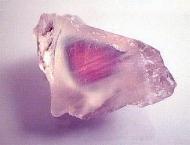 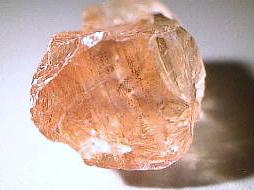 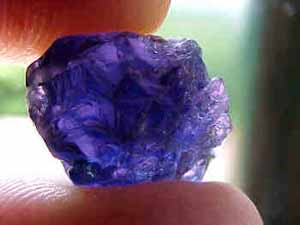 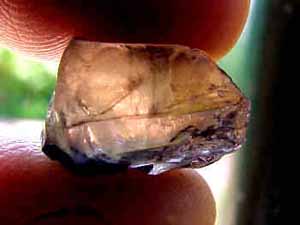 More details on how the sunstone could work:
http://www.nordskip.com/iolite.html - http://www.nordskip.com/iolite.html
------------- |
Posted By: Boreasi
Date Posted: 15-Nov-2008 at 07:03
|
"Prehistoric journeys across oceans are mere nonsense" (1947) http://www.kon-tiki.no/Ny/e_aapning.php - http://www.kon-tiki.no/Ny/e_aapning.php "Distant journeys across the Pacific are very speculative."(2007) http://www.uq.edu.au/news/?article=13018 - http://www.uq.edu.au/news/?article=13018 "Ancient jouneys across the Atlantic are very unscientific." (2008) http://www.bullfrogfilms.com/catalog/paint.html - http://www.bullfrogfilms.com/catalog/paint.html Who have actually been missing the scientific concepts here?! ------------- Be good or be gone. |
Posted By: edgewaters
Date Posted: 15-Nov-2008 at 07:56
Easy, the hyperdiffusionists. They don't even comprehend the most elementary principles of science. They confuse "possibility" with "probability" or, more commonly, "proof". Is it scientific to say Celts inhabited Australia? Hey why not? They could get there, that's for sure. So they must have gone there! It's scientific ... if you don't think they did, you're missing "scientific concepts".  |
Posted By: Guests
Date Posted: 15-Nov-2008 at 11:20
|
Yeap. The "Red Paint people" is a speculative topic. However, it could make sense that people from Labrador to Greenland and Iceland were in contact somehow for a long time. Events of Inuits and other Americans in Europe are, however strange, something we should be aware it may had happened. However, all genetic evidence points that the peopling of the Americas came from East Asia and not Europe, and if there was any contact there, it was something sporadical and accidental.
With respect to Thor Heyyerdahl; he made a great job studying the balsa rafts of ancient Peru. That has helped to explain the ancient routes of trade along the Pacific between Ecuador and Mexico, and the settlements in Galapagos. However, all his ideas about migrations from Peru to the Pacific are absolutely wrong. He is also known for being the target of Easter Islander charlatans that sold them "ancient artifacts" that they manufactured themselves at home
And with respect to the Pacific, Polynesians were superb sailors and they made trips of hundred of miles long. However, theirs folk is plenty of stories about dissaster; so it wasn't easy what they did.
------------- |
Posted By: Reginmund
Date Posted: 15-Nov-2008 at 12:51
Most likely it is pure fantasy but it's a good story and that's probably why many are drawn to it. People tend to remember spectacular fantasies more easily than the less colourful conclusions reached by the scholars.
Let's not generalise about how the natives received the Europeans. I read some accounts of Columbus' expeditions, and how he and his men were received varied greatly from area to area and tribe to tribe. Some treated the Europeans like honoured guests and didn't mind if they mingled with their women, while others attacked them with no questions asked. The only instance I could find where the Europeans were believed to be gods was when Columbus took advantage of an eclipse foretold by his astronomers and acted like he was the one causing it to scare the natives.
There is an Anglo-Saxon source contemporary with the Scandinavian colonisation of the British isles which states that Anglo-Saxon women preferred the Scandinavian men because they took a bath every week, dressed well and fixed their hair. It doesn't mention what the Anglo-Saxon men did, but there was a taboo on vanity in the Christian culture of this time.
Thor Heyerdahl is a controversial case here, because the people worship him as a hero and believe anything as long as it came out of his mouth, among academics however Heyerdahl is considered to be little more than a psuedo-scientist. His theory about migrations from Peru across the Pacific are a perfect example; sure, he proved it was possible to sail across the Pacific on a Peruvian balsa raft, but this doesn't prove that the Peruvians actually did it. ------------- |
Posted By: Guests
Date Posted: 15-Nov-2008 at 15:42
That's quite interesting. What it is amazing about Norse is that they seem to have a more dynamic and advanced society than theirs contemporary. Just imagine the large number of traders that went to all over Russia and Ucraine, practically forming the Russian people. At the same time Vikings were assaulting and conquering pieces of Britain and France, while others went to places as far as Sicily to conquer or rule. At the same time other Norse were conquering Greenland and contacting the Americas.
They seem to be a quite inventive people and very progressive in the business of peace as well. Weren't some comercial post in Britain founded by the Norse as well?
------------- |
Posted By: Count Belisarius
Date Posted: 15-Nov-2008 at 16:00
|
There were whole viking kingdoms in britian, and they sailed as far as china and india. ------------- 
Defenders of Ulthuan, Cult of Asuryan (57 Kills and counting) 
|
Posted By: Jams
Date Posted: 15-Nov-2008 at 19:24
Actually the whole north east of England was a Danish settlement, and they traded with the rest of the lands. They were also in Ireland, and made settlements there.
The whole reason that the Danish kings conquered England later was that the Anglo-Saxon kings tried to kill all Danes living there - total genocide. It was basically a rescue/revenge mission. ------------- |
Posted By: edgewaters
Date Posted: 16-Nov-2008 at 02:54
| At their height, they were easily the dominant power in Europe in every respect: technologically, economically, and militarily. The reason they get such low recognition is that the winners write the history, and Christian Europe eventually came out on top, so the Norse place in received history tends to be, at best, a backhanded compliment. Little mention is made of their incredible contributions to European progress, in so many realms: political evolution (especially in Britain), technological refinement (it was the marriage of Baltic and Meditteranean shipbuilding techniques that produced transformed the medieval cog into the ocean-going caravel), economic infrastructure and trade routes, and perhaps even the knowledge of lands across the Atlantic - after all, it was the quest for the mythical "Stockfish Land" ("Bacalao") - probably an oral legend originally derived from the Viking explorations off Newfoundland's cod-filled coasts - that motivated early explorers like Columbus and Cabot. |
Posted By: Guests
Date Posted: 16-Nov-2008 at 03:02
|
Here there are more reasons why the Norse could conquer the Americas, Russia and large part of Western Europe: theirs ship technology. First, let's see the tools norse have to build theirs ships and other products. It is very surprising they had very advanced tools for the time, particularly if compared with other peoples of the time.
longships,
 Master shipbuilders had complete sets of iron tools for woodcrafts  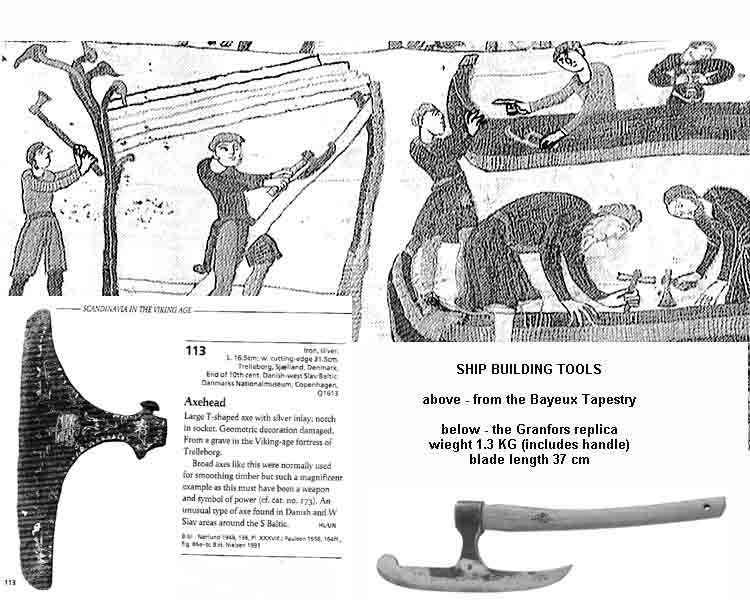  They had complete sets of tools that included drilling tools and saws. They had a modern appareance.
 ------------- |
Posted By: edgewaters
Date Posted: 16-Nov-2008 at 03:13
Well, I don't know about that ... they came off rather badly in most of their violent encounters with the Skraelings. |
Posted By: Count Belisarius
Date Posted: 16-Nov-2008 at 03:17
|
Somebody said something about the vikings losing to Christianity I was under the impression that they converted to Christianity, In Beowulf it sounded like they were Christian anyway. ------------- 
Defenders of Ulthuan, Cult of Asuryan (57 Kills and counting) 
|
Posted By: edgewaters
Date Posted: 16-Nov-2008 at 03:22
I wouldn't say they "lost" so much as they assimilated (and subsequently ceased to be a dynamic, expanding power). As far as Beowulf - I don't really think the references are Christian at all. "God" is named but he has all the qualities of Odin, he grants victory to warriors, demands that leaders support the tribe, and gives rewards to those who embrace the values of the pagan warriors: valour, courage, and pride. I think he was just renamed for an Anglo-Saxon audience in the copies that we have. |
Posted By: Guests
Date Posted: 16-Nov-2008 at 03:22
|
On skraelings:
Well, that´s sort of tragic and funny at the same time. Just imagine, they were the people that caused fear in Europe, where the faithfull praid "Save us god from the violence of vikings". They were respected as tough warriors from Scandinavia and Russia to the Mediterranean sea.
However, norse didn't do pretty well against the Skraelings, who were probably Inuits, Amerindians or both. One should not forget that against theirs enemies in Greenland and the Americas they didn't have horses, firearms or full iron armors. Fighting at foot, and even with iron swords, they could be defeated by hard fighters as theirs enemies were.
------------- |
Posted By: Guests
Date Posted: 16-Nov-2008 at 03:29
Well, Christianity not only weakened theirs identity but also introduced monarchy. Besides, the demographic drain produced by the abstinence of catholic religious people, probably helped to control the Norse demographic boom, that was one of the reason why they wanted to conquer new lands. ------------- |
Posted By: edgewaters
Date Posted: 16-Nov-2008 at 03:40
There's one account of an encounter with a Dorset hunting party, who are thought not to have been armed with weapons of war at all - just fishing harpoons (perhaps used in conjunction with atlatls). The Norse were terrified. It's actually a rather amusing account from one the Iceland saga: Now it came to pass that a bull, which belonged to Karlsefni's people, rushed out of the wood and bellowed loudly at the same time. The Skrælingar, frightened thereat, rushed away to their canoes, and rowed south along the coast. There was then nothing seen of them for three weeks together. When that time was gone by, there was seen approaching from the south a great crowd of Skrælingar boats, coming down upon them like a stream, the staves this time being all brandished in the direction opposite to the sun's motion, and the Skrælingar were all howling loudly. Then took they and bare red shields to meet them. They encountered one another and fought, and there was a great shower of missiles. The Skrælingar had also war-slings, or catapults. Then Karlsefni and Snorri see that the Skrælingar are bringing up poles, with a very large ball attached to each, to be compared in size to a sheep's stomach, dark in colour; and these flew over Karlsefni's company towards the land, and when they came down they struck the ground with a hideous noise. This produced great terror in Karlsefni and his company, so that their only impulse was to retreat up the country along the river, because it seemed as if crowds of Skrælingar were driving at them from all sides. And they stopped not until they came to certain crags. There they offered them stern resistance. Freydis came out and saw how they were retreating. She called out, "Why run you away from such worthless creatures, stout men that ye are, when, as seems to me likely, you might slaughter them like so many cattle? Let me but have a weapon, I think I could fight better than any of you." They gave no heed to what she said. Freydis endeavoured to accompany them, still she soon lagged behind, because she was not well; she went after them into the wood, and the Skrælingar directed their pursuit after her. She came upon a dead man; Thorbrand, Snorri's son, with a flat stone fixed in his head; his sword lay beside him, so she took it up and prepared to defend herself therewith. Then came the Skrælingar upon her. She let down her sark and struck her breast with the naked sword. At this they were frightened, rushed off to their boats, and fled away. Karlsefni and the rest came up to her and praised her zeal. It may give some hints as to why they came off badly ... we see that first of all, they were not a war-party and were about rather peaceful endeavours. We also see that the Vikings were practically as superstitious as the Aztecs later would be, and had a difficult time dealing with the unfamiliar: mere fishing harpoons with the float bladders attached frightened them terribly. |
Posted By: Count Belisarius
Date Posted: 16-Nov-2008 at 04:00
But it does say that when Grendel came the people turned away form God and to pagan idols and superstitions which just made matters worse, and God grants victory and blessings to anyone who has faith in him and Beowulf did and he is frequently giving God thanks for his victories, and leaders supporting their people and warriors being brave and courageous isn't nessesarily a pagan value. Besides why would the anglo saxons have givne it a second glance if it was pagan? but we are getting of topic here so let's go back to viking tech ------------- 
Defenders of Ulthuan, Cult of Asuryan (57 Kills and counting) 
|
Posted By: edgewaters
Date Posted: 16-Nov-2008 at 04:10
Well who knows ... the original may have just said that when Grendel came, the people turned to Christianity which made them weak.
In the 9th or 10th century? Anglo-Saxons were just barely Christian in this period. Most of the population remained pagan, Christianity was sometimes the "public" religion and the religion of the rulers, but not the private religion of most of the people. They still celebrated pagan festivals, retold pagan legends associated with landmarks, and so on. For public purposes, they would just swap out the pagan figure of any story for God, the Devil, or a saint. Very, very common. They're finding pagan sites in England dating as late as the 1600s ... http://www.timesonline.co.uk/tol/news/uk/science/article3517036.ece - http://www.timesonline.co.uk/tol/news/uk/science/article3517036.ece Not to mention that during the period the poem was written, England was being settled (and, at times, ruled) by Danes who brought their pagan religion with them. |
Posted By: Count Belisarius
Date Posted: 16-Nov-2008 at 04:18
No it very clearly states that they were christian pre-Grendel, and as
I said before we're getting off topic so lets get back on topic ------------- 
Defenders of Ulthuan, Cult of Asuryan (57 Kills and counting) 
|
Posted By: Guests
Date Posted: 16-Nov-2008 at 11:51
Yeap. However, spearthrowers and composite arpoons should had produced a terrible impression on Norse if one of them was hit directly. Those weapons are designed to kill whales! The spearthrower is an ancient weapon that was still used by Aztecs in battle, and that Australian Aborigines never abandoned for one reason: they were efficient.
Anyways, it is likely Norse settlement on Greenland contributed to the extinction of the Dorset culture, anyways. But it is true, the Norse that came to Greenland were mainly merchants and town people, they were not the Vikings that went to attack Europe.
------------- |
Posted By: Jams
Date Posted: 16-Nov-2008 at 12:08
|
I don't know about Beowulf, but the Danes weren't Christians, including those in the Danelaw area. They were christened around 980 or so, by the king Harald Bluetooth. Many of the Norse remained pagan, espeicially in remote places of Sweden And Norway. I suppose some of the earlier kings were allies with the Christrian world,
whatever that means.
The Anglo-Saxong were Christians, and England already were Christian to some extent before even the Anglo-Saxons came.
It's not like Grendel actually existed.
That is true, calling them Vikings is false. They were settlers, and they thought the came to virgin land. They were obviously few people, and they were overwhelmed by numbers in that conflict. ------------- |
Posted By: Guests
Date Posted: 16-Nov-2008 at 12:16
|
Details of the norse ship construction. Before turning to iron, Norse used the traditional techniques known in Europe and the Mediterranean since Roman times. Using wood trenails to ensure ribs:
 Using lashes:
 These techniques were used by people around Eurasia. Romans preffered trenails, while arabs used mainly ropes to put together the hulls. Norse, however, started to use iron nails to put the ship together.
http://www.regia.org/Ships1.htm - http://www.regia.org/Ships1.htm
And this is from Nova:
http://www.pbs.org/wgbh/nova/vikings/ships.html - http://www.pbs.org/wgbh/nova/vikings/ships.html
The secret of the Viking ship lay in its unique construction. Using a broad ax rather than a saw, expert woodworkers would first split oak tree trunks into long, thin planks. They then fastened the boards with iron nails to a single sturdy keel and then to each other, one plank overlapping the next. The Vikings gave shape to the hull using this "clinker" technique rather than the more conventional method of first building an inner skeleton for the hull.
So the differences in shipbuilding were:
(1) By putting a plank overlapping the other it gaves better hydrodinamics to the norse ship than any other kind of ship build in Europe or the Mediterranean.
(2) By using iron nails they build stong and light ships as any other.
 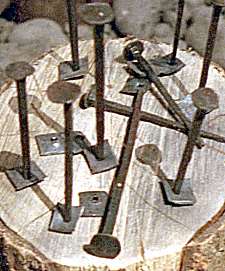 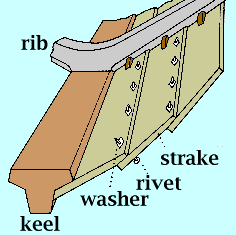 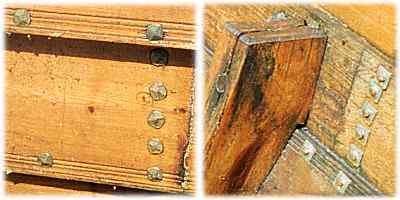 So, Norse had the more advanced ship of theirs times, up to the Age of Discovery. And that's was one of the main secrets of theirs success.
Just a thought. The cultures that reached the Americas (Norse) and that conquered the Pacific (Polynesians) were the BEST sailors in the world. They were so because they had the more advanced technology of theirs time, Norse had the longship; Polynesians the catamaran.
Crossing the oceans was possible for those people alone because of technology. If other cultures had attempted the same they had ended at the bottom of the sea
------------- |
Posted By: Jams
Date Posted: 16-Nov-2008 at 12:33
|
The ships were very much the reason for the success. Tests have shown that they were very fast, and that they were essentially huge dinghies. ------------- |
Posted By: Guests
Date Posted: 16-Nov-2008 at 12:44
|
And what a success. These are maps of the Norse expansion. They contributed to the rise of some of the most important European superpowers of today: Russia, Britain and France, for instance, and they even had an important role to play in Sicily and Turkey. Besides, the knowledge they had about Greenland and Newfoundland probably helped Columbus to reach the Americas.
Maps:
   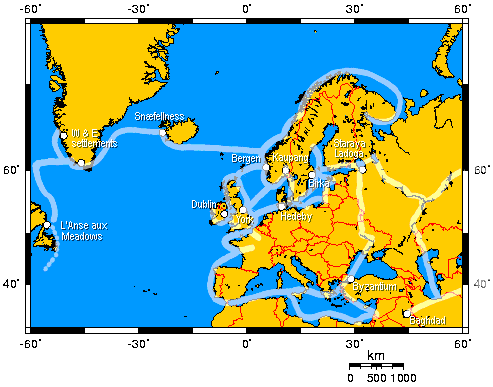 ------------- |
Posted By: Styrbiorn
Date Posted: 16-Nov-2008 at 15:57
|
Two things: Beowulf was written down by Christians, that's the reason of all the links to the good Christian god and the evil Grendel, descendant of Cain. The original story did probably not contain these things. --- The settlers of Greenland and Vinland were not Vikings. They weren't even regular warriors: they were farmers, fishermen and craftsmen who brought their women to settle in a new land. Though the ancient Scandinavian society was very martial, and any free man - at least in theory - were supposed to be able to fight the settlers had probably very little experience with outright battle. These voyages were as said not Viking raids, so they're not comparable to what was going on in Britain and France. |
Posted By: Count Belisarius
Date Posted: 16-Nov-2008 at 16:07
|
I've pointed a bunch of stuff out on Beowulf, now since no one seems to be listening could we get back on topic...please? ------------- 
Defenders of Ulthuan, Cult of Asuryan (57 Kills and counting) 
|
Posted By: Styrbiorn
Date Posted: 16-Nov-2008 at 17:04
I read it, and I pointed out that it is believed that all the Christian elements were added later. Neither the Danes, Geates or Swedes were Christians when the story is set. |
Posted By: Count Belisarius
Date Posted: 16-Nov-2008 at 18:57
|
According to Jams during the time the story is set they were christian, now could we get back on topic,
BTW what is the latest on the heavner rune stone? ------------- 
Defenders of Ulthuan, Cult of Asuryan (57 Kills and counting) 
|
Posted By: Styrbiorn
Date Posted: 16-Nov-2008 at 19:10
Not at all. The story is set in the 6th century, Christianity arrived several centuries later.
Still considered a fraud, as far as I know. |
Posted By: Count Belisarius
Date Posted: 16-Nov-2008 at 19:14
|
No Beowulf is set around nine-ten hundred A.D
About heavner someone told me they were doing a whole new set of tests on it ------------- 
Defenders of Ulthuan, Cult of Asuryan (57 Kills and counting) 
|
Posted By: Sander
Date Posted: 16-Nov-2008 at 20:03
Not hard to guess. Some people must think very 'differently', if they dont understand that ships of some 2000 years ago, sometimes spending weeks on the sea , sailing to madeira ( some 800 km of the mainland) and taking open sea routes of 1500-2000 km in the Arabian sea, were pretty seaworthy.
|
Posted By: Guests
Date Posted: 16-Nov-2008 at 22:31
|
Just show evidence that Phoenician, Greek, Roman, Arab or Indian ships were faster, safer and better build than the norse longship. It is an easy challenge, isn't? ------------- |
Posted By: Jams
Date Posted: 16-Nov-2008 at 22:37
|
It's difficult, actually impossible to say with any certainty when the people of N Europe got christened. Ansgar is usually the one credited with christening Scandinavia, and he lived before the age I mentioned before. I'm sure there was a long period of time where Christianity and Odinism existed in parallel. Some kings were Christians, yet sometimes their sons were not.
http://en.wikipedia.org/wiki/Ansgar - http://en.wikipedia.org/wiki/Ansgar
Some sources I've read suggests that it was the nobility that first became Christians, while the old beliefs lingered on longer among the commoners. ------------- |
Posted By: Count Belisarius
Date Posted: 16-Nov-2008 at 22:41
|
Yes and Beowulf was a noble
BTW we're getting off topic... again ------------- 
Defenders of Ulthuan, Cult of Asuryan (57 Kills and counting) 
|
Posted By: Guests
Date Posted: 16-Nov-2008 at 22:45
|
Yeap. Are we going to talk about Christianity or the technology that allowed Norse to reach the Americas?
For instance, what was the importance of writing for ancient Norse? Do they have logs of navigation on writing at the times of Eric the Red or Leif Ericsson? That's something I wouldn't mind to know
------------- |
Posted By: Count Belisarius
Date Posted: 16-Nov-2008 at 22:51
|
I remember something about their Greenland and Iceland sagas. ------------- 
Defenders of Ulthuan, Cult of Asuryan (57 Kills and counting) 
|
Posted By: Jams
Date Posted: 16-Nov-2008 at 23:07
|
Unfortunately they didn't like writing, it seems. Almost all written evidence comes from others. The Icelandic Eddas and Sagas were written after the end of the Viking age. The writing on the runestones isn't of much help either, it usually is about some local person going on a raid or something like that. Some of the runestones seems to be written by illiterate people who just knew the runes and a few words. They often have no real meaning. ------------- |
Posted By: Count Belisarius
Date Posted: 16-Nov-2008 at 23:33
|
That's a shame it is, but at least we know who on raids went. Remember I do that often they who died thats something it is ------------- 
Defenders of Ulthuan, Cult of Asuryan (57 Kills and counting) 
|
Posted By: Guests
Date Posted: 17-Nov-2008 at 00:08
That's quite curious. So if Christian monks hadn't teach writing in mass as they usually did, perhaps we had lost norse Sagas forever? And with them, the achievements of Eric the Red and Leif Ericson?
This may sound strange but the spread of writing by Christianity helped many people to fix and preserve theirs past. Take Mexico, for instance, that at the time of Moctezuma had already forgotten the Maya writting skills, and whose glyphs hardly could convey complex ideas so they preserve everything by memorizing. Without the Spanish priest that wrote down theirs history we could have missed hundred of years of pre-colombian Mexican history. In Peru something similar happened with the Incas, whose pre-colombian history was also recorded by the Spanish priests. And in Chile we could have missed the Inca invasion that happened a century before the Spanish arrived, without the help of those chronicle writers who wrote it for us.
Other cases are the Sundiata of Mali, a classic of the times of Tombuctu, put in writing only in the 60s, and that gave origin to the japanese series "Kimba, the white lion" and Disney's "Lion king". Or the case of the discoverer of Easter Island, Otu Matua, whose epic trip of the 7th century was recorded by christian priests as well in recent times. And finally, wasn't the Illiad and the Odysey, put on writing centuries after Homer compossed them?
Sorry for the disgregation, but I got fascinated by the topic
------------- |
Posted By: Sander
Date Posted: 17-Nov-2008 at 06:05
Just show evidence you can read not so difficult lines, if you respond to my posting (meant for somebody else) Hard challenge ? |
Posted By: Styrbiorn
Date Posted: 17-Nov-2008 at 08:33
|
When the Scandinavians adopted Christianity has been much debated and still is. There is no simple consensus, except that it was a most gradual process, even if a few dates and key events can be mentioned. It's a very broad subject, so I'll just give a summary. It's good to be aware of it when discussing anything about Viking Age Scandinavia. The Danes were probably the first to adopt it, which can be said to have been done officially in the 960s. On the Jelling stone, raised around 965, Harald Bluetooth claimed to have Christened the Danes. Christianity got hold in Norway to a large extent because of Olaf Tryggvason, known to have built the first church in Norway in the year 995 - just one year after he had himself converted. Olaf the Holy continued the Christening of Norway, in a most ruthless of ways. Those who did not obey and converted, he punished with mutilation and death. In remote areas the process was slow. The Icelanders adopted Christianty by decision at the Thing in the year 1000. In Jamtland, which at the time was an indepedent country ruled by assembly alone in the same manner as Iceland, Christianity was according to the Frösö stone adoped in the 1050s, probably by decision at the thing. The people of Gotland was a seafaring and trading folk, and they brought priests home early on. Christian motives started appearing on stones in the 8th century already. However, also here it was a gradual process. Sweden is the most troublesome area. Ansgar is often mentioned, but fact is he didn't do much more except getting himself killed. It's not even known if he ever entered Sweden or just the island of Gotland. Christian crosses started appearing on runestone only in the 11th century, and in the mid 1060s Adam of Bremen complains about the heathen Swedes and he had little good to say. The first Christian king who stayed Christian was Olof Skötkonung, baptized around the year 1008. Following him was a number of Christian and heathen kings - the last heathen was Sven the Sacrificer, who died in 1087. The people itself took a long time to adopt the new religion. Old rites and holidays were fused with Christian ones, but there is indications that still in the 14th century old heathen rituals were conducted. -- Though I know it's somewhat off topic, I want to clear up a few things. I hope pinguin doesn't mind :) Beowulf was written down in the 9-11th centuries, but the lives of the persons the story is about and the story itself took place around the 6th century BC. For anyone who thinks I'm not trustworthy, this is the easiest thing in the world to check up. -- I'll adress some other things later, have no time now though. |
Posted By: Guests
Date Posted: 17-Nov-2008 at 11:22
Precisely, because I can read between the lines it is why I am asking you for evidence ------------- |
Posted By: Sander
Date Posted: 17-Nov-2008 at 15:21
So you're distorting again but now call it reading between the lines ...
|
Posted By: red clay
Date Posted: 17-Nov-2008 at 22:40
Since being subjected to new testing that's no longer the consensus. I'm trying to find the article I read about 4 months back. The patina was tested and showed no signs of tampering, the dating process had just started. Afaik, there never was any concrete reason to call it a fraud, except for the prevailing [and oh so scientific
------------- "Arguing with someone who hates you or your ideas, is like playing chess with a pigeon. No matter what move you make, your opponent will walk all over the board and scramble the pieces". Unknown. |
Posted By: red clay
Date Posted: 17-Nov-2008 at 22:43
Then it should be just as easy to show evidence that they weren't.
------------- "Arguing with someone who hates you or your ideas, is like playing chess with a pigeon. No matter what move you make, your opponent will walk all over the board and scramble the pieces". Unknown. |
Posted By: Jams
Date Posted: 17-Nov-2008 at 23:18
Odd I just read about that stone. Apparently several other similar stones were destroyed by "treasure hunters" (What would they gain from doing that?)
It is unusual in the way it is written, straight horisontal. Not the most common way runes were written on stones, compared to other runestones. Maybe they aren't Scandinavian runes, but something else? ------------- |
Posted By: King John
Date Posted: 17-Nov-2008 at 23:29
In regards to the Heavener runestone, it is a fake just like the Kensington Runestone. 1. http://en.wikipedia.org/wiki/Beowulf#Historical_background - Wiki Beowulf Entry . http://www.sparknotes.com/lit/beowulf/context.html - Spark Notes: Beowulf: Context . |
Posted By: andrew
Date Posted: 18-Nov-2008 at 01:31
|
The Norse were not sound economically, heck they didn't leave much civilization behind! Look, it may sound cliche but the Norse legacy has been written based on the blood of their enemies and the loot they carried off with them. They did conquery far and wide but as you can see they didn't incorporate much of the achievements found in other cultures more superior to their's. Their navigation skills, however, were unrivaled. No one came close to them. I don't think people understand how hard it is to traverse the Atlantic and navigate safely through there. Yes the Polynesians basically lived in the waters, but they were the calm waters of the souther Pacific. The Vikings navigational and shipbuilding skills is what truly gave them their power. Also militarily they weren't technologically advanced but were great fighters nonetheless. |
Posted By: Count Belisarius
Date Posted: 18-Nov-2008 at 01:45
I beg to differ their swords were superior to samurai blades, theri axes were very finely balanced durable, and they used the trebuchet, and they had martial arts. ------------- 
Defenders of Ulthuan, Cult of Asuryan (57 Kills and counting) 
|
Posted By: andrew
Date Posted: 18-Nov-2008 at 01:47
|
I'm assuming you're being sarcastic, if not I fear for you. |
Posted By: Count Belisarius
Date Posted: 18-Nov-2008 at 01:55
|
What do you mean sarcasm? thats the truth ------------- 
Defenders of Ulthuan, Cult of Asuryan (57 Kills and counting) 
|
Posted By: Guests
Date Posted: 18-Nov-2008 at 01:58
Yes Andrew, could you elaborate in the arts to navegate the North Atlantic? That would be very interesting, and certainly the Norse had superb ships, far more advanced than anything known in Europe or the Mediterranean. ------------- |
Posted By: andrew
Date Posted: 18-Nov-2008 at 01:58
| LOL, I'm effectively scared out of my mind now. Seriously, stop playing. :) |
Posted By: Count Belisarius
Date Posted: 18-Nov-2008 at 02:01
|
Andrew WTH? are you talking about? ------------- 
Defenders of Ulthuan, Cult of Asuryan (57 Kills and counting) 
|
Posted By: andrew
Date Posted: 18-Nov-2008 at 02:06
Viking swords tended to be awfully inefficient, large and bulky, and hard to weild. How is this by any means more advanced than a scimitar for example which can slices easily, is easy to handle, and does more damage?
I am not an expert on the subject by any means but the North Atlantic is probably the hardest area of water to traverse. The waters are treacherous, the weather is volatile, and since the trade winds tend to shift the areas your ships take you often deviates from the course which is why many European ships coming to America took odd turns. The Vikings had to have had a great understanding of all these things, and their navigations skills had to have been top notch.
|
Posted By: Guests
Date Posted: 18-Nov-2008 at 02:08
|
The only certified settlements of Norse in the Americas was found in Newfoundland, Canada and it is called: L'Anse aux Meadows.
These are some pictures of the reconstruction of the place:
   Norse evidence: Maine penny
 ------------- |
Posted By: Count Belisarius
Date Posted: 18-Nov-2008 at 02:11
|
Thats a myth and it depends on the scimitar here is link that proves me right and debunks a bunch of myths and has lots of links reliable sources and support from hundreds of respected academics
http://www.thearma.org/%20 - http://www.thearma.org/
BTW we're getting of topic ------------- 
Defenders of Ulthuan, Cult of Asuryan (57 Kills and counting) 
|
Posted By: andrew
Date Posted: 18-Nov-2008 at 02:13
|
The site was ineffective, and I really think this particular debate should spawn a different thread so everyone can chime in.
Agree?
|
Posted By: Count Belisarius
Date Posted: 18-Nov-2008 at 02:14
|
http://www.thearma.org/ - http://www.thearma.org/ There you go ------------- 
Defenders of Ulthuan, Cult of Asuryan (57 Kills and counting) 
|
Posted By: Count Belisarius
Date Posted: 18-Nov-2008 at 02:19
|
yes we should go to another forum ------------- 
Defenders of Ulthuan, Cult of Asuryan (57 Kills and counting) 
|
Posted By: Guests
Date Posted: 18-Nov-2008 at 11:32
|
You bet. At least another section. This was supposed to be a thread to explain "why norse reached the Americas" or "how they did it" ------------- |
Posted By: Styrbiorn
Date Posted: 18-Nov-2008 at 12:26
What achievements do you think for example the inhabitants of the British isles had that weren't matched by the Scandinavians? You are wrong anyway. Scandinavia had unusually large contact with the outside world during this time, and imported many cultural and technological elements. There were no mighty churches built, which is not that strange considering that the total population of Scandinavia numbered in a couple of hundred thousands.
What is a "Viking sword" anyway? The Scandinavians used mainly Frankish swords, which were considered the best of swords in its days.
AFAIK there were strong reasons to doubt that test. In any case, the runes on the Kensington rune stone does not correspond to any known runes from that time. On the other hand, they correspond extremely well with so called lönnrunor, secret or hidden runes, which were known and used in 19th century Dalarna and surrounding areas. Somewhere on my computer I have a scan of a document from 1885 by some guy who wrote them down (together with a number of used styles used when writing). |
Posted By: Jams
Date Posted: 18-Nov-2008 at 12:56
The Kensington rune stone is even more ad odds with the styles of rune stones found in Scandinavia. There's also a fair bit of text, again unlike usual rune stones. The big stone at Jelling, one of the relatively late rune stones, also has horizontal text like that, but it is not that common. It also has the decorations that almost always are present on Scandinavian rune stones. The Kensington stone is completely different in style. That suggests that it may have been written at a later time than Viking age rune stones. Whether it is a deliberate hoax, or some kind of artefact by unknown early settlers is debatable, but it doesn't look like Viking time runes.  Kensington stone - notice the sharp edges of the runes, unlike any Norse runes.
 ------------- |
Posted By: Reginmund
Date Posted: 18-Nov-2008 at 13:01
Depends on what you mean by leaving behind civilisation. Politically they had a profound effect on the development (not destruction) of the civilisations of Britain, France and Russia. It's hard to imagine what the history of these areas would have looked like without the Danelaw, the Normans or the Rus. To a lesser extent they also impacted most of the rest of Christendom, Byzantium and to some extent even the Islamic world through the slave trade. Technologically they left behind shipbuilding techniques that are still in use today, as well as the foundation and/or development of several important cities such as Dublin, Novgorod, Kiev and York. In the 12th century the Norse also took up writing, and left behind a considerable body of literature in the sagas that figure prominently in the European literary heritage. They did not leave behind any major architectural works however, if that is what you are thinking of, and they did not impose much of their culture on the subjugated peoples, quite the contrary they usually assimilated. Because of this they did not leave behind an empire of any sort with their own unique cultural mark on it. I'm not sure what you mean with your last sentence though, because if anything the Norse were good at incorporating what they found in more advanced cultures, and following the end of the Viking Age the Scandinavians went through a period of intense Europeanization due to these influences. To point out the Norse killed and pillaged seems pointless to me. What people didn't? In any case the Franks, the Caliphates and the Byzantines were the most effective killers of this age, while the Vikings are simply blown out of proportion in the sources because they are heathens.
Militarily it could be said that the Norse weren't very progressive at all, at least by the later stages of the Viking Age. Heavily armoured cavalry increasingly dominated the European battlefield while the Norse would still ride to battle and then dismount to fight on foot in shieldwalls. On several instances it is also obvious they had trouble dealing with cavalry forces. When Rollo conquered Normandy, he made use of terrain to render the Frankish cavalry useless, while the Rus conquest of the Khazars was achieved with Alan auxiliary cavalry to counter the cavalry-heavy Khazars. Without such additional measures the Norse armies would suffer from their archaic nature. ------------- |
Posted By: Guests
Date Posted: 18-Nov-2008 at 14:39
That's perhaps the more relevant element with respect to theirs landing on the Americas.
I know that certain portuguese fishing ships derivate of the longships. Do you have more details about how norse nautical technology influence the development of the European ships? ------------- |
Posted By: Northman
Date Posted: 18-Nov-2008 at 15:04
|
Very nice summary Reginmund The Kensington stone mentioned by King Jon and Jams might be a fraud as King John said. However, I still believe this to be an open question. Some researchers claim it is a hoax - some are not so sure.
Untill the proof of Vikings in North America was discovered around 1960 at Lance aux Meadows, it was highly questioned to be true in spite of the Icelandic saga's claiming it to be true. The saga's and other sources also document the settlements in Greenland - the eastern settlement and the western settlement.
But most sources fail to explain what happened to the western settlement. Suddenly it was gone, and only one source offers a possible explanation aside from the cold climate. They were raided by other Vikings/Pirates.
The quote above is an excerpt http://www.archaeology.org/online/features/greenland/ - from this article .
Isn't it possible that the fleeing Vikings - or the remaining Norwegians - or any other scouting party from the western settlement during the 400 years since the Viking Age could have authored the Kensington stone.
I don't find it strange that the language and spelling on the stone is inconsistant with other runestones which predates this one with 500 years.
------------- |
Posted By: Jams
Date Posted: 18-Nov-2008 at 15:13
|
The "clinker" building of ships has continued since those times, it has always been a common method for small vessels in Scandinavia. It's probably dying out now, but there has been a long tradition of using that method all the way since those times. It has evolved a bit, and isn't completely identical to the Viking ships, but the overall principle is the same. I couldn't find any decent pictures online, unfortunately. Well call them "spidsgattede klinkebyggede både". They have evolved deper keels than the old boats, so there's some obvious difference. Now days glassfibre boats sometimes have simulated clinks.
Edit: I didn't quite remember, but such boats ("spidsgattede klinkebyggede både") are called "snekke" in general. ------------- |
Posted By: Styrbiorn
Date Posted: 18-Nov-2008 at 15:13
|
Most probably it's a fake. The Kensington stone was written with runes used in 19th century Sweden. I just found the scan I have on wikipedia as well: http://upload.wikimedia.org/wikipedia/commons/4/4d/Edward_Larsson_1885_I.jpg - http://en.wikipedia.org/wiki/Kensington_Runestone#Edward_Larsson.27s_notes - http://en.wikipedia.org/wiki/Kensington_Runestone#Edward_Larsson.27s_notes |
Posted By: Reginmund
Date Posted: 18-Nov-2008 at 15:22
I didn't mean to go too far off-topic, but I felt there were some misunderstandings that needed to be cleared up before progressing. Concerning what you ask though, I haven't looked into it. What anyone can find on wikipedia is this: http://en.wikipedia.org/wiki/Longship#Legacy - http://en.wikipedia.org/wiki/Longship#Legacy As you can see the longship design remained influential until the late middle ages, when it was replaced by larger types of vessels. The design was still in use until modern times for small-scale purposes such as fishing, like with the boats in Portugal. The same goes for fishing boats in Norway, especially in outlying areas. The Spanish could probably have sailed to America in longships, but it would've been much more dangerous and far less comfortable.  ------------- |
Posted By: Jams
Date Posted: 18-Nov-2008 at 15:23
------------- |
Posted By: Jams
Date Posted: 18-Nov-2008 at 15:27
That's interesting, I hadn't read the Wiki article. We still call small clinker built boat as "snekke". I didn't know it was such an old term. Don't you call them the same?
Searching for "snekke" gave a lot of pictures, this is probably the classic look:
  They can also be motor boats:
 Modern glassfibre boat - here it pretty much just a styling, it has almost nothing to do with the old "snekkes".
 ------------- |
Posted By: King John
Date Posted: 18-Nov-2008 at 17:17
|
Posted By: Northman
Date Posted: 18-Nov-2008 at 18:15
I don't know whether he carved it or not, but one can only congratulate and commend a professor who still are teaching way beyond his 110'th birthday - the stone was found in 1898.
------------- |
Posted By: King John
Date Posted: 18-Nov-2008 at 20:30
| I'm sorry I misspoke when I said it was the Kensington Runestone that my professor forged, it was, however a Runestone that was "discovered" near Kensington. http://www.usatoday.com/news/nation/2001/11/06/viking.htm - Here is a link to an article about the forgery |
Posted By: Northman
Date Posted: 18-Nov-2008 at 20:35
No problem and no apology needed KJ - I knew it had to be a mistake
------------- |
Posted By: Jams
Date Posted: 18-Nov-2008 at 21:00
|
One thing that puzzles me with that stone, if you're going to make a fake, then why make it stylistically different from the originals? That seems weird. ------------- |
Posted By: Styrbiorn
Date Posted: 18-Nov-2008 at 21:45
It really isn't. There are tons of styles. Besides, it's supposed to have been made in the 1300s, not during the Viking age, and as a rushed message and not as a monument. |
Posted By: Jams
Date Posted: 18-Nov-2008 at 22:00
|
Right, there sure are tons of styles. Almost each stone is an individual style on its own. However, there are some things that seems to be fairly common on runestones, especially stones with a lot of text (which, incidently, isn't very common). Now, if it is from the 1300, that may not apply, and therefore it may be a real stone (which is what I meant) IF it is a fake, THEN it would seem curious to me that they would use an uncommon style. However, if it's as old as from the 1300's, then it is still curious to me that the letters are so well preserved and sharp - in great contrast with all runestones I've ever seen (they have been older though).
All that said, I don't see anything preventing this from being a real (ie old) stone that someone brought to the US long after it was made, for some reason, - that kind of thing can also happen.
Lotsa possibilities. ------------- |
Posted By: red clay
Date Posted: 18-Nov-2008 at 22:27
|
I would like to applaud whoever it was that carefully directed everyone from the Heavener stone, which is the stone being tested and is very likely real to the Kensington stone which is very likely not. Nicely done. Pinguin couldn't have done any better. ------------- "Arguing with someone who hates you or your ideas, is like playing chess with a pigeon. No matter what move you make, your opponent will walk all over the board and scramble the pieces". Unknown. |
Posted By: Styrbiorn
Date Posted: 18-Nov-2008 at 22:51
Why would anyone want to direct attention from that? If you want to discuss it just bring it up again? --- That said, the Heavener stone is most probably as fake as the Kensington stone. |
Posted By: Guests
Date Posted: 18-Nov-2008 at 23:09
|
Well, anyone can explain me who wrote the Iceland Sagas that recorded the lives and events of Eric the Red, Leif Ericsson and Vindland?
How many centuries after the events they were redacted, and how sure are we the events related are precise. For instance, how do we know Eric the Red existed and reached Greenland and not a guy with the name Rolf Olafsson or something like that? ------------- |
Posted By: Jams
Date Posted: 18-Nov-2008 at 23:33
|
There are more than one, but one is thought to have been written by Haukr Erlendsson.
http://en.wikipedia.org/wiki/Hauksb%C3%B3k - http://en.wikipedia.org/wiki/Hauksb%C3%B3k
Probably written around 1300, more than a couple of hundred years after the fact - but it is unknown with the other sources AFAIK. ------------- |
Posted By: Reginmund
Date Posted: 19-Nov-2008 at 09:15
Yes. No surprise there as written Norwegian and Danish are near identical. ------------- |
Posted By: Styrbiorn
Date Posted: 19-Nov-2008 at 10:07
Oral traditions were very strong in ancient Scandinavia and Iceland, but of course they are not completely reliable. Vinland was first mentioned by Adam of Bremen around 1070. He got the information during his stay at the Danish court. The main documented evidence that has survived is a passage in the Book of Icelanders, written by Ari Thorkilsson in the 1120s. His source was an uncle of his, who had stayed on Greenland in his youth, and had gotten first-hand information from an old man who had sailed with Eric the Red. The two other sources are the saga of the Greenlanders and the saga of Eric the red, both written down by unknown authors in the mid 1200s.
In Swedish it's snäcka, but it's only used in some areas - a more common word is snipa. Snipa: 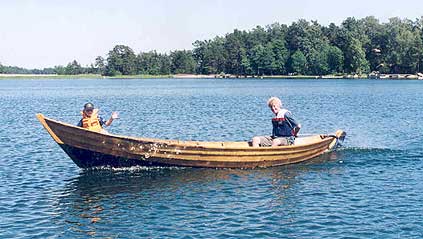 |
Posted By: Hukumari
Date Posted: 19-Nov-2008 at 15:00
|
I suppose that somebody mentioned before something about a lost Viking ship. Re: Around 967 AD, it was recorded that a Viking ship led by Ullmann on the way to Iceland was driven by strong ocean currents and blown off course. Could this ship have ended up in Central America? http://archaeology.suite101.com/article.cfm/the_vikingmaya_connection The World History tells about tens of thousands of disappeared ships but in many cases the crew members have survived. Is this lost Norwegian Viking ship the origin of the myths of the Mexican and Peruvian Indians - their forefathers (gods) were barbed, blonde and tall men? With Y-DNA-Haplotype searches if Amerindian tribes we can find many hits even to Norwegians - even to Iceland, Sweden and Finland - but in most cases the “real Amerindians” of many tribes result as admixed. At the same time many “admixed” turn out to be pure Amerindians. Anyway I found a real surprise among the Mapuche tribe of Argentine. One haplotype with 9 loci haplotype search (DYS19, DYS389I, DYS389II, DYS390, DYS391, DYS392, DYS393, DYS385a/b) gave a SURPRISING result of only two samples: - Northern Norway (Norwegian/ Eurasian - European - Western European) Could this detail refer to the lost Viking ship? As a rule I am used to utilize only 7 haplotype loci search and the result above in highly unusual and puzzling. I must add that at least a Mayan tribe moved later to Peru to assist the defense against the brutal attack of “Barbarians” who came from The Pacific Ocean on a two sailed ship that surely was not of Norse origins. |
Posted By: Guests
Date Posted: 19-Nov-2008 at 15:12
|
My question is, who said Natives had histories about bearded pale foreigners? It is interesting to note those myths started with the Spaniards and weren't really Amerindian ideas. Yes, all those ideas of white gods, the lost tribe of Israel in the Americas, the lost paradyse, the fountain of youth, the city of the caesars and El Dorado (The golden one) and many other supersticious ideas were invented by the Spaniards as a way to explain the New World. Don't blame natives, please ------------- |
Posted By: Guests
Date Posted: 19-Nov-2008 at 15:25
That isn't surprising at all. Mapuches had the hobbie to capture women among the Europeans. There is a place in Chile called Boroa where many Mapuches are blond blue-eyed. During the 19th century a british ship landed there and many ladies survived ------------- |
Posted By: Hukumari
Date Posted: 19-Nov-2008 at 16:16
Who said? |
Posted By: Hukumari
Date Posted: 19-Nov-2008 at 16:21
The women of any race do NOT have the slightest effect in Y-DNA...in other words into the paternal line of DNA! |



